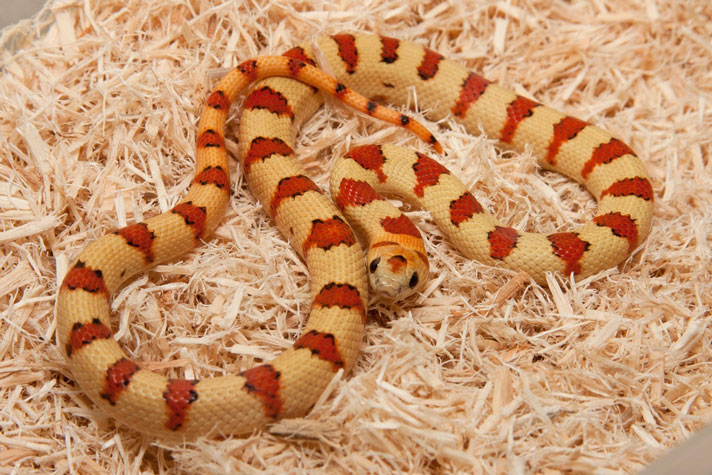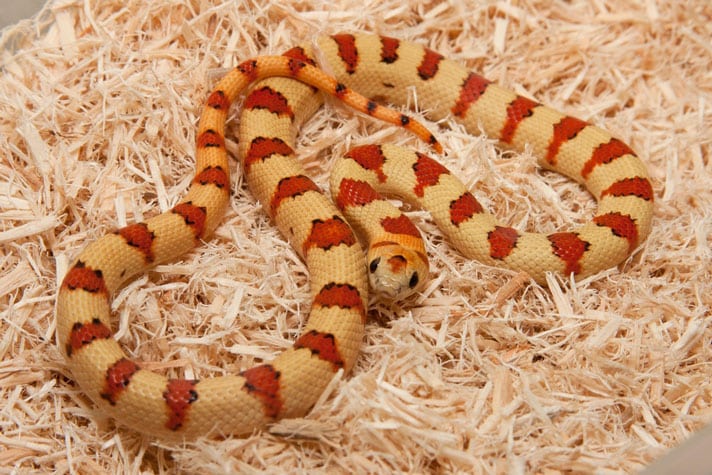Most of the available captive bred Nuevo Leon kingsnakes are many generations removed from the wild due to the laws protecting their importation into the US.
Updated January 30, 2023
Nuevo Leon Kingsnake – Lampropeltis mexicana thayeri
Nuevo Leon kingsnakes are also known as the Variable Kingsnake, Thayer’s Kingsnake or simply Thayeri. Captive requirements are very similar for all kingsnakes in the Mexicana Complex (L. m. mexicana, L. m. greeri, L. m. thayeri, L. ruthveni, L. alterna and L. webbi). Nuevo Leon kingsnakes inhabit the northern portions of the Sierra Madre Oriental, primarily in the states of Nuevo Leon and Tamaulipas. They are also recorded to be found in extreme eastern Coahuila and the western and eastern flanks of the Sierra Madre.
Other Kingsnakes
Gray-Banded Kingsnake Care Sheet
California Kingsnake Care Sheet
How to Care for Mole and Prairie Kingsnakes
Nuevo Leon Kingsnake Availability
Most of the available captive bred Nuevo Leon kingsnakes are many generations removed from the wild due to the laws protecting their importation into the US. The Lacey Act was amended in the late 1980s to include foreign countries’ laws protecting their native wildlife. Since then very few wild specimens have entered private collections. Nuevo Leon kingsnakes are now widely available in the herpetoculture. They are very intriguing to newcomers and experienced hobbyists alike mainly due to their very unpredictable variability within a single clutch. Many breeders compare hatching Nuevo Leon Kingsnake eggs to Christmas in the Summer or the proverbial “box o’ chocolates,” because you never know what color or pattern will emerge from the egg.

Nashepard/Shutterstock
The Nuevo Leon kingsnake is also called the variable kingsnake.
There are two phases of Nuevo Leon kingsnakes. One phase resembles a milksnake because it is a tricolored banded morph. These are called Milk Snake Phase or MSP thayeri. The other phase has an alterna-like pattern with red saddles bordered with black. These are called Leonis Phase thayeri. There is a melanistic morph as well that emerges from its egg very dark with a faint underlying Leonis or MSP pattern. After a few sheds it becomes totally black.
Nuevo Leon Kingsnake Size
Nuevo Leon kingsnakes hatch from their eggs at 6 to 12 inches. The average adult size for Nuevo Leon kingsnakes is around 3 feet in length and they rarely reach 3-1/2 feet. Four feet is unheard of for this subspecies of mexicana kings.
Nuevo Leon Kingsnake Life Span
As with most colubrids, Nuevo Leon kingsnakes often live for more than 20 years. Female Nuevo Leon kingsnakes often produce fertile eggs well into their teens. Males have been known to produce viable sperm their entire life, but this is not the case for all individual animals.
Nuevo Leon Kingsnake Caging
Of the utmost importance is to make sure your kingsnake enclosure is escape proof using reptile screen tops with locking clips for security. A kingsnake will find any flaw in its security and will escape. A hatchling Nuevo Leon kingsnake can live in a shoebox-sized enclosure for its first year depending on frequency of feeding and growth rate. Once the kingsnake is longer than ½ of the perimeter of the enclosure it is time to up the size of the caging. Typically a 15 qt. tub or 10 gallon terrarium will house a yearling to sub-adult kingsnake for the second year of its life but again this all depends on the kingsnake’s growth rate. Adults will comfortably live the rest of their life in a 20 gallon equivalent enclosure. The larger the better to give these animals plenty of roaming space.
It is important to provide your captive Nuevo Leon kingsnake with many temperature, security and humidity options. Hot/dry, cool/dry, hot/damp and cool/damp combinations are what you are trying to achieve. In each enclosure make sure there is a temperature and humidity gradient that is measured using a thermometer and humidity gauge. It is optimal to keep your kingsnakes in a room that is a constant 72F or so. Then there should be a non lighting heat source in one spot or end of the enclosure. In addition to a thermal gradient you should provide a humidity gradient. A water bowl can usually achieve this but if you want an optimum humidity gradient it is best to fill a container with damp sphagnum moss. Make sure the container is large enough for the snake to completely enter. Place this container so that a portion of it is on the hot side and the rest on the cool side. This will create all the options/choices for your kingsnake. Use deep aspen shavings and place some sort of cover or hide box on top of one side of the substrate. This cover will make a good “serving plate” for prey items and provide a top-to-bottom thermal gradient along with the end-to-end gradient. If you are concerned about your snake ingesting substrate, feed it in a separate container.
Young Nuevo Leon kingsnakes can consume other snakes, utilizing live reptile food including other thayeri and should be kept separate. Adult Mexican kingsnakes can be housed together only if there is a single male in the breeding group, but a single male can live with multiple females. Never house multiple males together. The recommended time to put your breeding colony together is just prior to their first adult brumation period. I recommend separating for feeding, waiting a few hours then placing them back together.
Nuevo Leon Kingsnake Lighting and Temperature
Nuevo Leon kingsnakes require no special lighting if the cage is in a room with natural light. Heat lamps or lighting that gives off any heat is not needed at all for kingsnakes. Be sure to keep your kingsnakes out of direct sunlight for any duration of time and do not place your aquarium by a window.
Nuevo Leon kingsnakes thermoregulate in the wild. They move about to find and maintain a preferred temperature and humidity level. These cold blooded animals become the temperature of their surroundings. It is recommended to keep your kingsnakes in a cool room with a provided “hot spot” so the kingsnake can find its desired temperature. There are many different types of heaters, pads, cables and heat tape available from reptile product dealers to accomplish a “hot spot.” Some use these products for belly heat or back heat. This hot spot is used for digestion and thermoregulating. A good hot spot is from 85 to 90 degrees Fahrenheit. The enclosure should have a cool side at one end with temperatures in the mid 70s so that the snake can conserve energy. Use a temperature gun to record these temperatures and adjust to accomplish them. Never use “hot rocks,” the heat is too centralized and can cause burns on your snake.
Nuevo Leon Kingsnake Substrate
There are many commercial substrates and beddings available for reptiles. Avoid cat litter and, anything that is chemically treated and do not use oily woods like cedar. Aspen shavings and coco coir are good choices. Feed your kingsnake in a separate container if the substrate could be ingested while feeding or place prey items on a paper plate or plastic lid. If you do not want to use aspen shavings you might consider a hide or two in the cage for security. It is recommended to provide a moist hide as well. The preferred substrate for a moist hide is moistened sphagnum moss. Soak the moss and wring it out. Re-wet the moss weekly.
Nuevo Leon Kingsnake Food
Prey consumed by captive Nuevo Leon kingsnakes should be slightly larger than the diameter of the snake or they should be fed numerous smaller prey items. Nuevo Leon kingsnakes feed primarily on lizards and rodents, although lizard eggs, snake eggs and amphibians have been known as prey items for wild Nuevo Leon kingsnakes. Hatchling thayeri are naturally lizard feeders but some will readily take newborn pink mice. Others require some enticement techniques to get them readily feeding on rodents. Nuevo Leon kingsnake breeders typically do not sell offspring unless they are established rodent feeders. Frequency of feeding is determined by the age/size of the kingsnake.
A growing kingsnake will want to eat two to three times a week. An adult king will want a prey item around once a week. There is no set “schedule” for feeding kings. Feeding schedules are the keeper’s and not the snakes. A few good rules of thumb are to feed after the kingsnake passes feces or when the snake is on the cool end of its enclosure conserving energy. The animal will sometimes turn down food when the natural light cycle shortens in the winter. Adult breeding males will sometimes go off feed during the breeding season (Spring and early Summer). If breeding kingsnakes it is important to feed them well all Summer so that they can endure a brumation period. It is also important to feed ovulating breeding females to ensure good development of egg follicles.
Nuevo Leon Kingsnake Water
Provide fresh water in a bowl on the cool side of the enclosure. Make sure that it is deep enough that when the bowl is large enough for the snake to soak its entire body and that the water will not overflow into the cage while the snake is soaking. Clean the water bowl as needed and at least once a week.
Nuevo Leon Kingsnake Handling and Temperament
Young Nuevo Leon kingsnakes can be slightly jumpy but with age they will become very docile. Your new kingsnake might take a defensive stance and vibrate its tail and strike at you. It may defecate, musk or urinate on you when you pick it up. This potential behavior is natural and it is only defending itself with what Mother Nature gave it. With regular, gentle handling, your Nuevo Leon kingsnake should settle in and make a docile pet. Always support your kingsnake with both hands when handling it. Use a hand over hand method and keep your hand away from its head. Loosely hold the snake and let it crawl through your hands.
Don’t handle your snake when it is about to shed or after it just finished a meal. A way to tell that your snake is about to shed is to look at its eyes. If they are “cloudy” or bluish in color they are in a shed cycle. In a few days they will clear up and slough off their old skin. Be sure to consult experts if you have further questions or have any problems. Enjoy your Nuevo Leon kingsnake!
John Lassiter has been a kingsnake keeper, kingsnake breeder and field herper for over 20 years. John’s main focus is on the Mexicana Kingsnake Complex and is working with and has produced some of the best stock available in the hobby. Visit his website at Coastalbendcaptivebreeding.com for all your Mexican kingsnake needs and information.


